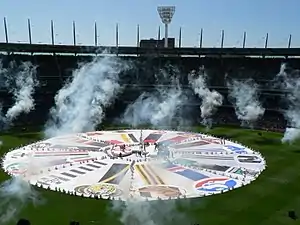Grand final
Primarily in Australian sports, a grand final is a game that decides a sports league's premiership (or championship) winning team, i.e. the conclusive game of a finals (or play-off) series. Synonymous with a championship game in North American sports, grand finals have become a significant part of Australian culture. The earliest leagues to feature a grand final were in Australian rules football, followed soon after by rugby league. Currently the largest grand finals are in the Australian Football League (AFL) and National Rugby League (NRL). Their popularity influenced other competitions such as soccer’s A-League, the National Basketball League, Suncorp Super Netball and European rugby league's Super League to adopt grand finals as well. Most grand finals involve a prestigious award for the player voted best on field.


History
The Anglo-Norman term "grand" to describe a sporting event, documented in England as "grand match" in 1836,[1] was used in Australia from the 1850s. A steeplechase in England has been called the "Grand National Steeple Chase" ("Grand National" alone for short) since at least 1839.[1]
Use of the term in Australian Football dates back to the first organised and widely publicised match between Melbourne Grammar School and Scotch College on 7 August 1858 at Yarra Park, Melbourne (formerly Richmond Park). The game was advertised as the "grand football match" in the Melbourne Morning Herald and several other local newspapers.[2]
In 1859, a "grand football match" was advertised in Richmond, Tasmania for St Patrick's Day on Friday 18 March.[3]
In The Argus of 1861, the Royal Caledonian Society of Melbourne invited clubs to compete in a "grand football-match" which was to be football's first ever trophy, the Caledonian Challenge Cup, however the match did not proceed until the following year.
The earliest known event described as "grand" in Sydney was a cricket match in 1862.[4]
In the 1871 South Yarra Challenge Cup, Carlton and Melbourne drew their three matches, but also won their remaining matches against the other clubs, Albert Park and South Yarra. As head-to-head record was the only tiebreaker at that time, the team captains and the Cup organisers arranged a "grand match", as advertised in The Argus, at the Lake Oval to decide the premiership on October 7, a week after the season had finished. Carlton won by two goals to nil.
Initially, a football premiership final appeared to be called a "grand final" only when the losers of a final were the minor premiers and they exercised the "right to challenge" the winners to a second premiership decider.[5]
South Australian Football Association
Prior to 1889, the South Australian Football Association (SAFA, now SANFL) was awarded to the team that finished top of the end-of-season ladder placings.
In 1889, Norwood and Port Adelaide finished equal first with 14 wins and one draw, meaning a play-off was required to determine the premiership. In promoting the play-off, the local press referred to it as a "premiership match".[6] This was played on October 5, and Norwood won the match 7.4 to 5.9.[7]
In 1894, Norwood and South Adelaide finished with a 13-5 record from their 18 matches. The play-off match was fixed for October 6, and despite a provision for 20 minute periods of extra time in the event of a draw at full time, the match was abandoned due to darkness with the scores level at 4.8 apiece.
The SAFA fixed a replay for October 10, Labor Day: this was the first of seven grand final replays in elite Australian football history. Norwood won the replay 4.7 to South Adelaide 3.5 with a goal from Bos Daly as the final bell rang.[8]
Victorian Football Association
In the Victorian Football Association, which was Victoria's top level of senior football from 1877 until 1896, the premiership was typically awarded solely on the basis of the rostered premiership matches (known today as the home-and-away season). However, the rules stipulated that where two or more teams finished equal on premiership points, a playoff match or matches would be scheduled amongst those teams to determine the premiers.
This was required in 1896, when South Melbourne and Collingwood finished level on top of the ladder with records of 14 wins and one draw. The playoff match between them, which is retrospectively treated as Victoria's first Grand Final (it was the first match referred to as such), was won by Collingwood 6.9 – 5.10.[9]
While there was one previous premiership playoff match during this time in the VFA, between Melbourne and Geelong in 1878, this match did not break a tie at the top of the ladder, as Geelong had a superior win-loss record to Melbourne: the match was organized to resolve a dispute between the two clubs.[9]
Victorian Football League and Australian Football League
In 1897, when eight teams broke away from the VFA to form the VFL, the concept of finals football was high on the agenda, with teams buoyed by the success and attendances of the 1896 Grand Final. Over the following ten years, all top-level Australian football leagues adopted a finals structure.
In 1931, the VFL adopted a system, the Page–McIntyre system, which ensured a grand final, and the concept became entrenched.
New South Wales Rugby Football League
The New South Wales Rugby Football League (NSWRFL) experimented with a finals system in 1908, its inaugural year, but abandoned it the following season. Finals were reintroduced in 1926, and the premiership decider appeared to only be called a "grand final" if it involved the minor premiers.
By the 1930s, the NSWRFL adopted the term "grand final" to describe the premiership decider.[10] Up until 1954 a 'grand final' match was only held if the minor premiers were beaten.[11] The adoption of the VFL's Page–McIntyre system for the 1954 NSWRFL season meant for the first time grand finals would become necessary every season, so the term grand final has become used to describe all premiership deciders.
The tradition is maintained by the present-day NRL National Rugby League.
Europe
The term "Grand Final" was introduced to Europe in 1995 in a completely different sport—golf. In that year, the Challenge Tour, the official developmental tour for the European Tour, launched its season-ending Challenge Tour Grand Final. British rugby league would adopt the term in 1998, two years after the start of Super League. The Super League Grand Final has now become an accepted part of the British scene, and the term 'grand final' is used to describe the final of leagues below Super League as well, such as the Championship, Championship 1 and the Conference. Prior to this, a Championship Final was introduced to determine the winner of the British Rugby Football League Championship in 1904, though it only became a regular fixture from 1906 onwards. In 1973, the competition format was changed so that the championship was won by the team finishing top of the league table, with an end of season knock-out competition for the top teams that became known as the Premiership being created.
Starting in 2009–10, the rugby union competition historically known as the Celtic League, at the time involving teams from Ireland, Scotland and Wales, introduced a playoff system to determine its champion. (Although the league conducted a knockout competition in its early years, it was a parallel cup competition instead of a championship tournament.) The final match was branded as a grand final. This usage continued for the 2010–11 season, the first that included teams from Italy. Starting with the 2011–12 season, the first under the current sponsored name of RaboDirect Pro12, the "Grand Final" terminology was scrapped; the final match is now simply called the "Final".[12]
List of current notable competitions with grand finals
Sport
In television
The Grand Finals are also adopted in numerous reality television and even game shows. In reality television, a number of selected finalists after surviving a pre-determined number of elimination rounds moved on to the finals. Some shows, such as the earlier seasons of The Voice (notably the first two American seasons) and Project SuperStar, adopted a group-type format with an equal number of finalists from each group eliminated and advancing each show until one such finalist remain, at this point these finalists compete head-to-head for the champion. Taiwanese show One Million Star (and its sequel successor Chinese Million Star) uses a cumulative point system and the scores are progressively added until at one point the contestant with a lower score is eliminated; in the final round, these scores are converted as a percent weightage and the champion is decided based on the weighed scores.
In game shows, notably Jeopardy! (such as Tournament of Champions and The Greatest of All Time), these finalists compete in a two-legged round, based on the combined scores from both games, to determine the winner. From 1996 to 1998, Wheel of Fortune have a Friday Finals system where the three top-scoring contestants from the first four episodes that week returned again on a Friday for one more game; the winner in that episode will play for an extra prize package (in addition to the current prize the contestant chose) during the bonus round.
Grand final replays
A grand final replay is a method of deciding the winner of a competition when a grand final is drawn by replaying the entire match the following week, rather than playing overtime or extra time on the same day. It is commonly used in Australian rules football and most notably in the Australian Football League, where it has been used three times, most recently in 2010, however the AFL decided that replays will no longer decide grand finals that end as a draw, rather replacing it with extra time.
Grand final breakfast
Most sports leagues in Australia have a grand final breakfast to mark the beginning to grand final day. It is a social highlight on the Australian sporting calendar. Watching the event is a ritual for many footy fans and the function plays a huge role in the pre match build up for the grand final. The North Melbourne Football Club host the North Melbourne Grand Final Breakfast and the National Rugby League host the NRL Grand Final Breakfast at Sydney Convention and Exhibition Centre in Darling Harbour normally. Messenger Premier League also have a grand final breakfast.
See also
Footnotes
- Ross, J. (ed), 100 Years of Australian Football 1897–1996: The Complete Story of the AFL, All the Big Stories, All the Great Pictures, All the Champions, Every AFL Season Reported, Viking, (Ringwood), 1996. ISBN 0-670-86814-0
References
- Oxford English Dictionary 2nd. ed, grand (9A)
- Melbourne Morning Herald. 7 August 1858
- http://trove.nla.gov.au/newspaper/article/2467822
- http://www.rl1908.com/clubcomps/grand-final.htm
- "Football: Rugby League Final". The Argus. Australia. 7 September 1923. p. 4. Retrieved 4 December 2009.
- "Advertising". Evening Journal. XXI (5955) (SECOND ed.). Adelaide. 4 October 1889. p. 1. Retrieved 3 February 2018 – via National Library of Australia.
- "THE FIGHT FOR THE PREMIERSHIP". The Advertiser. Adelaide. 7 October 1889. p. 6. Retrieved 12 August 2013 – via National Library of Australia.
- "The Final Struggle". South Australian Chronicle. Adelaide. 13 October 1894. p. 15. Retrieved 12 August 2013 – via National Library of Australia.
- Observer (28 September 1896). "Football Notes". The Argus. Melbourne. p. 6.
- "RUGBY LEAGUE: Grand Final". The Sydney Morning Herald. Australia. 8 September 1931. p. 13. Retrieved 4 December 2009.
- "The start of a grand tradition". The Sun-Herald. 1 March 1987. Retrieved 10 December 2011.
- "Final Homepage". Celtic Rugby Limited. Retrieved 20 April 2012.